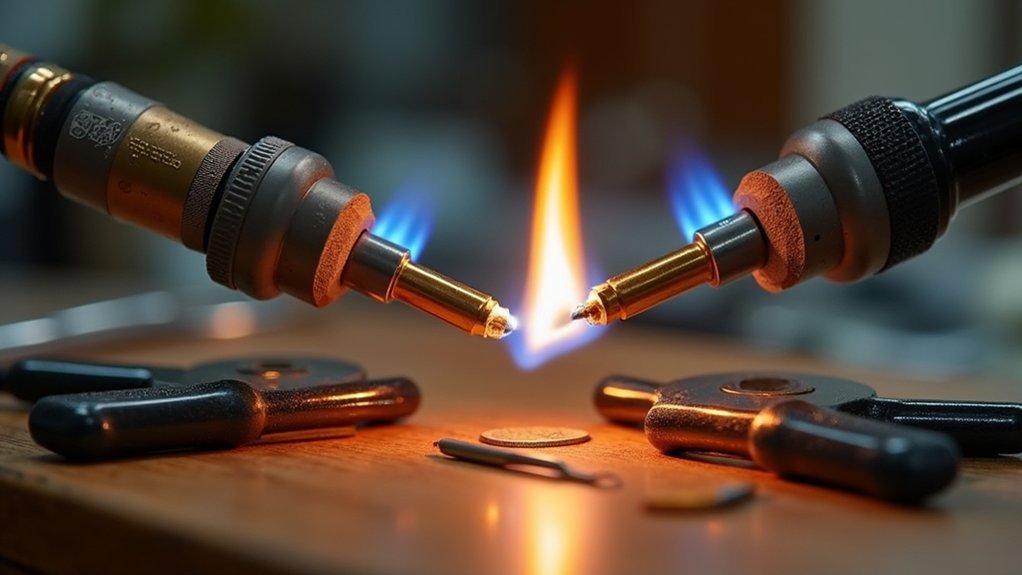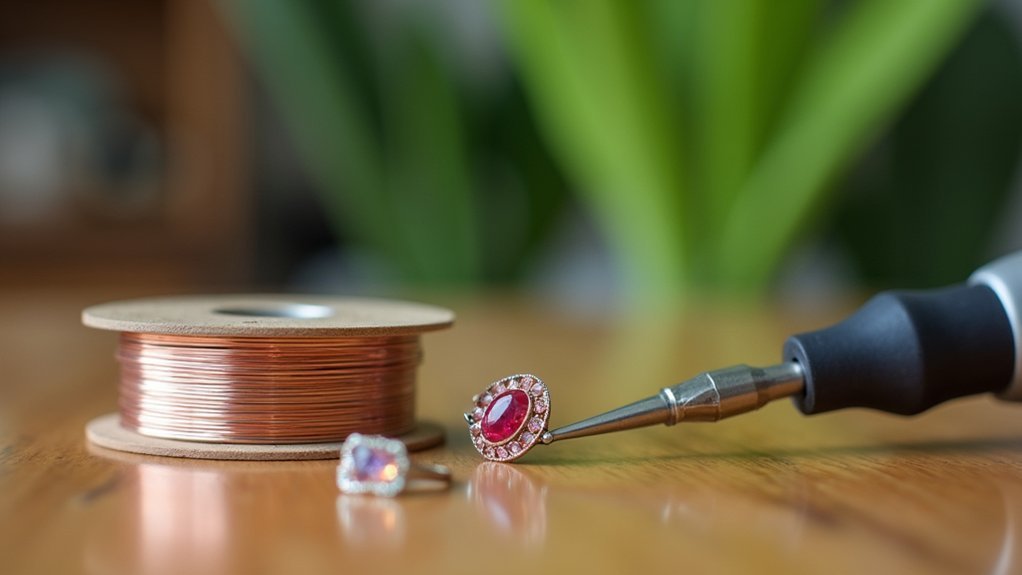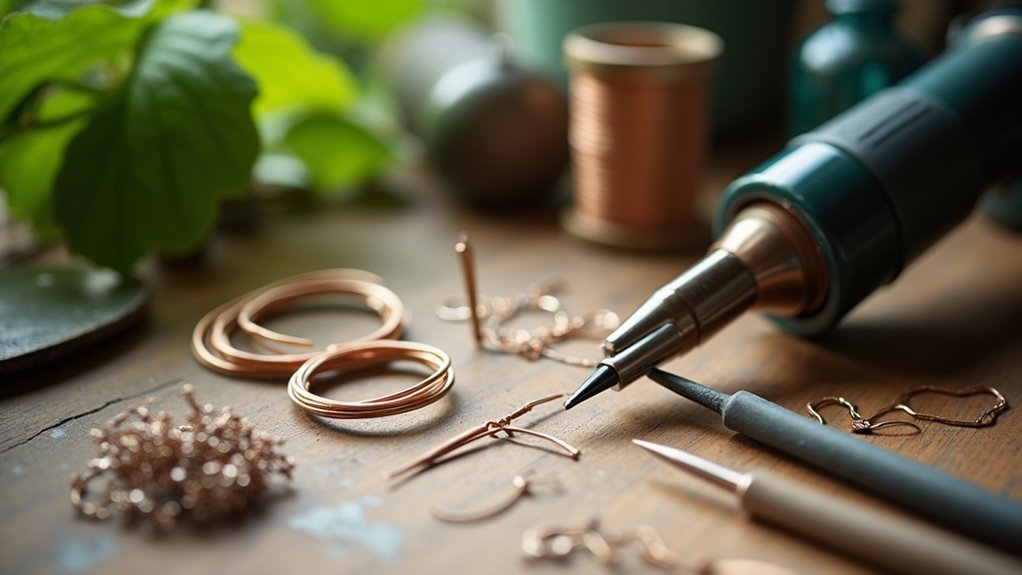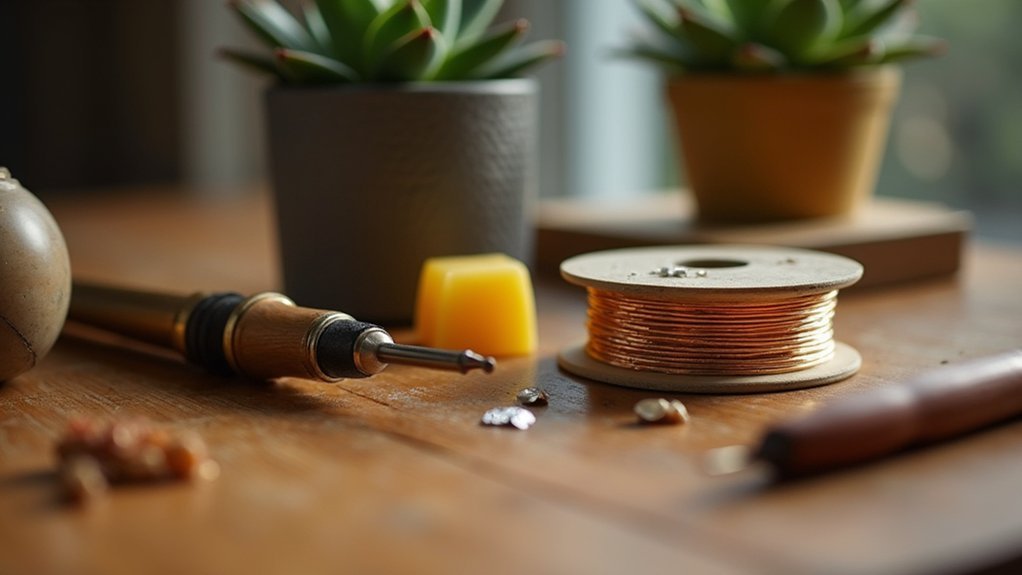You’re probably aware that traditional jewelry soldering methods aren’t exactly kind to the environment. Between toxic flux chemicals, energy-hungry torches, and wasteful metal practices, your craft might be contributing more to pollution than you’d like to admit. But here’s the thing – you don’t have to sacrifice quality or efficiency to clean up your soldering game. These five straightforward changes will transform your workshop into an eco-conscious operation.
Choose Hydrogen or Natural Gas for Clean-Burning Flames

When you’re looking to reduce your environmental impact while soldering, hydrogen and natural gas offer the cleanest-burning alternatives to traditional fuels.
Hydrogen stands out as the most environmentally friendly option, producing only water vapor when burned—making it perfect for sustainable practices in jewelry making. Natural gas burns cleaner than other fossil fuels, greatly reducing harmful emissions from your workshop.
Hydrogen produces only water vapor when burned, making it the cleanest fuel choice for environmentally conscious jewelry makers.
If you don’t have access to larger gas systems, you can still maintain eco-friendly standards with a butane torch, which provides clean-burning flames and excellent portability.
These gas choices help you comply with environmental regulations while supporting responsible jewelry making. By switching to these clean-burning flames, you’ll create a healthier workspace and contribute to reducing your craft’s carbon footprint.
Select Non-Toxic Flux and Natural Pickling Solutions
Beyond choosing clean-burning fuels, you’ll want to select non-toxic flux and natural pickling solutions that protect both your health and the environment.
Choose eco-friendly flux alternatives like Citpic and Hard Soldering Flux from Gesswein, which guarantee smooth solder flow while reducing environmental impact during your soldering process.
For cleaning, replace harsh chemicals with natural pickling solutions. A simple salt and vinegar mixture using a 3:1 or 4:1 ratio effectively removes oxides and residue.
Citric acid provides another excellent option to clean metal without toxic fumes or chemical waste.
These sustainable jewelry-making practices eliminate health risks from traditional pickling methods while maintaining professional results.
You’ll create a safer workspace and contribute to environmental protection without compromising your craft’s quality.
Use Low-Temperature Soft Solder to Minimize Energy Consumption

While traditional silver solder requires temperatures exceeding 1200°F, you can greatly reduce your energy consumption by switching to low-temperature soft solder like StayBrite, which melts at just 430°F.
This environmentally friendly alternative cuts heating costs while maintaining quality connections for jewelry applications.
You’ll find soft solder particularly effective for glass frame pendants and costume jewelry repairs. The lower soldering temperature means less energy use and reduced environmental impact—perfect for sustainable jewelry practices.
When you combine tinned copper wire and foil with low-temperature soft solder, you can create intricate designs without excessive heat damage to materials.
Adopting eco-friendly practices like low-temperature soldering markedly reduces your workshop’s carbon footprint while producing high-quality jewelry that meets professional standards.
Purchase Used Equipment and Recycle Metal Materials
Your soldering practices become even more sustainable when you purchase used equipment and commit to recycling metal materials. Buying second-hand tools considerably reduces your carbon footprint by minimizing demand for new manufacturing while keeping equipment from landfills.
You’ll find high-quality used soldering equipment through local jewelry making communities and online platforms, supporting a circular economy.
Recycling scrap silver and gold conserves natural resources and dramatically reduces energy consumption compared to mining new metals. Processing recycled metals requires considerably less energy than extracting fresh materials, making it one of the most effective eco-friendly practices available.
Additionally, purchasing used equipment creates considerable cost savings, allowing you to allocate funds toward sustainable materials and other environmentally conscious practices in your jewelry making workflow.
Hand Fabricate Jewelry Instead of Energy-Intensive Casting Methods

When you choose hand fabrication over casting methods, you’ll dramatically reduce your jewelry making’s energy consumption while gaining precise control over your materials.
Hand fabrication delivers superior material control while slashing energy use compared to traditional casting methods.
Traditional casting requires high temperatures and extensive machinery, creating a significant carbon footprint. Hand fabrication lets you shape and solder components directly, eliminating energy-intensive processes while promoting sustainable practices.
You’ll find that hand fabrication encourages exceptional craftsmanship and allows you to create truly unique pieces.
By working with off-cuts and scrap materials, you’ll reduce waste and minimize the need for newly mined resources. This eco-friendly approach aligns perfectly with growing consumer demand for sustainable jewelry.
Your soldering skills become essential tools for connecting hand-formed elements, transforming raw materials into beautiful, environmentally conscious creations that showcase your artistic vision.
Frequently Asked Questions
What Is the Best Soldering Tool for Jewelry Making?
You’ll find electric soldering irons with digital temperature control work best for jewelry making. They provide consistent heat levels essential for delicate work, while professional stations offer interchangeable tips for various applications.
What Kind of Solder Is Safe for Jewelry?
You’ll want lead-free solder for safety, eliminating toxic exposure. Silver solder offers durability and strength for fine jewelry, while tin-based soft solder works well for costume pieces and less demanding repairs.
Why Won’t My Solder Melt Jewelry?
You’re likely not heating the metal itself to proper soldering temperature. Clean oxidized surfaces thoroughly, guarantee tight-fitting joints, apply generous flux, and verify you’re using compatible solder for your specific metal.
What Is the Golden Rule of Soldering?
You’ll always want to guarantee both metal surfaces are completely clean and free from oxidation before soldering. This prevents dirt or grime from blocking proper solder flow and creates stronger joints.
In Summary
By switching to hydrogen or natural gas torches, you’ll create cleaner flames while reducing harmful emissions. You can eliminate toxic chemicals by choosing citric acid-based flux and pickling solutions. Don’t overlook low-temperature soft solders – they’ll cut your energy consumption considerably. Buying used equipment and recycling metal scraps keeps materials out of landfills. When you hand fabricate instead of casting, you’re using less energy while creating truly unique pieces that reflect your environmental commitment.





Leave a Reply